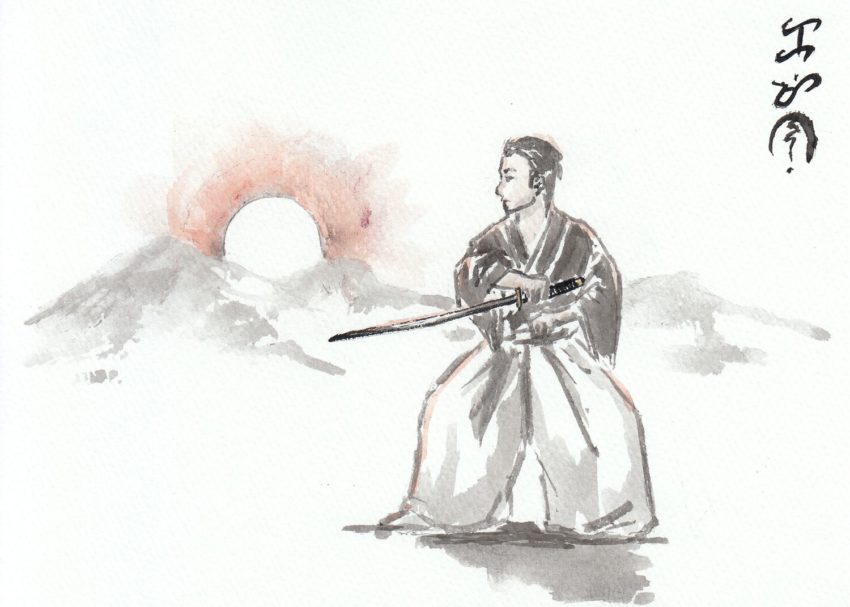It could be argued that the only thing cooler than a Japanese sword, or nihontoNIHONTO 日本刀 "Japanese sword" learn more..., is reading or watching accounts of people using them. This article intends to highlight some of the most notable Japanese sword fighters to have ever fought with a nihonto, including modern athletes with a reputation in the sport of kendoKENDO 剣道 "the way of the sword" learn more....
Miyamoto Musashi
Was Miyamoto Musashi an excellent samuraiSAMURAI 侍 "warrior serving a lord" learn more...? No. Was he an excellent swordsman? Yes! Musashi is actually regarded as one of the most prolific ronin in recorded history. He is known to have emerged as the winner in at least 60 duels. He created multiple schools dedicated to the arts of swordsmanship. And he even penned The Book of Five Rings, a meditative text on tactics and Buddhism. According to his book, Musashi grew up in what we now call the Hyogo Prefecture. Its believed that his father too was a skilled swordsman, who served the lord of Takeyama Castle.
Musashi’s career as one of the preeminent Japanese sword fighters started at a young age. When he was no older than 13, he brazenly accepted the challenge of a ronin named Arima Kihei. Musashi proceeded to defeat Kihei by using a washing pole rather than any sort of blade. Not only did Musashi win the challenge, against a man merely using a wakizashiWAKIZASHI 脇差 or 脇指 "medium-length sword" learn more..., but he beat the ronin to death with the six-foot-long wooden pole.
Many of Musashi’s later battles are known to involve a bokkenBOKKEN 木剣 "wooden sword" learn more... rather than a metal blade. His numerous other accolades include disbanding the membership of Kyoto’s Yoshioka school of swordsmanship, and being granted the title “Unrivaled Under Heaven” by the Yoshioka dojo’s sensei.
Musashi’s Opponents During His Pilgrimage
After expelling the Yoshioka, Musashi took up a warrior pilgrimage from 1605 until 1612, during which time he would duel against a variety of differently trained and armed opponents.
- While in Nara, he fought a Buddhist priest skilled in spears. Technically, this engagement occurred prior to his pilgramage, but it is still worth a mention
- Shishido Baiken, a master of the kusarigama, fought in Mie Prefecture in 1607
- Muso Gonnosuke, a master of the five-foot-staff, fought in Edo in 1608
- Hayashi Osedo and Tsujikaze Tenma, also fought in Edo, but two years later in 1610
Defeating such Japanese sword fighters wasn’t all that Musashi accomplished. The year of 1612 also serves as the date that Musashi would engage in his most well-known of duels. He was traveling throughout Funajima, an island within the Kanmon Straights dividing Kyushu and Honshu. After irritating his opponent, Sasaki Kojiro, by showing up for the clash several hours past the arranged time, Musashi defeated Kojiro. Musashi’s weapon of choice in this engagement? A bokken that he had carved from the oar he used to row his way to Funajima. Now that’s style.
After helping to construct Akashi Castle in his home prefecture and planning Himeji’s layout, Musashi tried contract work as a sensei in swordsmanship or serving various nobles, including Tokugawa Ieyasu. Come 1633, Musashi decided to settle down as a servant to Kumamoto Castle’s daimyoDAIMYO 大名 "feudal lord" learn more.... It is during this time that he relied on the sword less and hobbyist painting more. A decade later, he would seclude himself within a cave in Kumamoto in order to pen The Book of Five Rings. Two years later, after completing the work in February of 1645, he died within the cave in June.
Musashi’s Legacy Among Japanese Sword Fighters
While Musashi’s legacy continues in the forms of countless media, one of the major elements that has been retained in popular memory would be his signature style of swordsmanship. The “Niten Ichiryu” school of swordsmanship he founded translates as “Two Heavens as One.” It’s a style that focuses on combining a large blade, like a katanaKATANA 刀 "sword" learn more..., with a wakizashi. The only reason that Musashi is not more well known among academics and historians is due to his relatively minimal influence on Japanese history, likely a consequence of his ronin lifestyle.
The Musashi Masamune is a rare surviving weapon that Musashi allegedly owned. It is a tachiTACHI 太刀 "great sword" learn more... that was forged by Masamune, one of Japan’s greatest sword smiths, and is currently on display within a museum as a Japanese National Treasure.
On the Niten Ichiryu Style
This discipline of swordsmanship may have its origins in observing how temple drummers would move each of their hands in concert, rather than treating them as two separate components. The details of one discipline could be absorbed by the best Japanese sword fighters even if the area of study was completely unrelated.
Alternately, the use of the wakizashi as a defensive mechanism may arise from the lessons Musashi’s father taught him in the use of a jutte. Jutte were commonly used to parry and disable an opponent and the wielder’s other hand would use a lager blade to end the opponent. Musashi also developed a reputation for regarding his short sword as expendable, frequently throwing them as a distraction or opening move that would leave his opponent off-guard.
Ashikaga Yoshiteru
Also known by the names Yoshifushi and Yoshifuji, Yoshiteru earned the nickname of “kendo shogunSHOGUN 将軍 "medieval military commander" learn more...” due to his frequent practice and use of kendo. Indeed, he was regarded as the closest the Ashikaga clan had to a proper samurai since Ashikaga Takauji, the dynasty’s founder. One of his teachers in the ways of the sword was Tsukahara Bokuden, founder of the Kashima Shinto Ryu style of combat. Kashima Shinto Ryu taught its students to use the sword, spear and glaive in order to find an opponent’s weak points. The discipline also taught a series of iaijutsuIAIJUTSU 居合術 "the art of drawing a katana" learn more... techniques. Iaijutsu is a style where the user defeats an opponent in the middle of a motion of drawing and re-sheathing a katana.
Kawakami Gensai
Kawakami is another of the legendary Japanese sword fighters. Although born with the name of Komori Genjiro, he soon gained his current name after becoming a member of the Kumamoto clan by adoption. After enrolling into the Jishukan school, he did well in academics but poorly in combat. His failures as a martial artist can be attributed to a disdain for using bamboo shinaiSHINAI 竹刀 "bamboo sword" learn more... in lieu of a proper metal blade. After turning 16, he was made to serve as cleaning staff for Kumamoto Castle. Here Kawakami took the time to better himself and his skills.
A few decades later, and now with deep interest in imperial loyalty, Gensai married Misawa Teiko, a martial artist skilled in the naginata. After serving Kumamoto forces as a security detail in Kyoto in 1862 and some political events, he became the yojimbo to Sanjo Sanetomi. Soon after then, he quit his job as a monk and eventually abandoned service to the Kumamoto. The year 1864 saw the death of his mentor Miyabi Teizo by the hands of the Shinsengumi.
The series of losses Gensai suffered led him to becoming an assassin, working with a trio of others to dispatch Sakuma Shozan, a politician and scholar who believed that Japan should study European topics. This assassination took place in the middle of the day in August 12, 1864, with Gensai landing the single, fatal stroke. In a quote by Gensai detailing his thoughts on the incident, he described it as exhilarating for having felled the greatest man of Japan. While some claim that other assassinations were Gensai’s work, only Shozan’s death can be confirmed to involve Gensai.
Once he felled Shozan, Gensai engaged in the military efforts of Takasugi Shinsaku’s volunteer milita against the shogunate’s campaigns into the Choshu domain. It is during the Tokugawa’s second Choshu campaign that he helped win the battle for Choshu. Despite his successes, he later decided to surrender to Kumamoto forces during an subsequent engagement in Kokura. He would not be released until after the Meiji Restoration of 1868.
After his freedom was re-established, Gensai changed his name to Kouda Genbei and worked as a military officer and swordsmanship teacher for the Kumamoto clan. Eventually evidence of his sympathies with the militia would be made known and he would be arrested in 1870, then imprisoned in 1871. A year later, he would be decapitated and subsequently buried in Tokyo, one of the last truly notable Japanese sword fighters of his era.
If you happen to fancy certain anime or manga, elements of Gensai’s life sound familiar to you. The creator of Rurouni Kenshin has admitted that many elements of Gensai’s life and character served as the base inspiration for the character of Himura Kenshin. While Rurouni Kenshin also features a minor character named Doctor Gensai, this character is an old man with no connection to the real life Gensai beyond the name.
Japanese Sword Fighters and Modern Collectors
It should be remembered that just because these notable swordsmen were all Japanese, that does not mean that Japanese ancestry is necessary to own a Japanese sword. Versions of the sorts of swords these men used are freely available to interested connoisseurs of Japanese blades. Anyone with reservations to training with a razor-edged blade can get over those worries with a nonlethal bamboo shinai or bokken.
After all, the bokken was certainly enough for most of Musashi’s duels. If one of the great Japanese sword fighters could make do with such a weapon, then the swords available to buyers and collectors today are more than beautiful enough.

